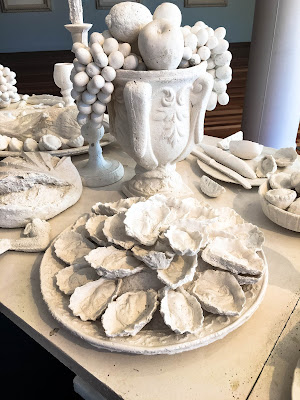Five years ago I went to an exhibition at NGA Contemporary. The gallery closed the next day. It's not my fault, honest - the gallery on the Lake Burley Griffin waterfront was only open for 18 months with articles at the time citing 'the federal government's continued efficiency dividend imposed on several cultural institutions' or 'relentless government cutbacks' as the reason for the closure. Anyway, I was clearing some photos from my phone because it's full (hard to believe, I know, being as it's still got photos from five years ago on it...), and I came across these from the exhibition so I thought I would share.
In two major installations, artists Ken and Julia Yonetani explore the notion that although the world appears rich in natural resources, the well-being of the planet is held in precarious balance. The first exhibition, Crystal Palace: The Great Exhibition of the Works of Industry of all Nuclear Nations is a provocative response to the Fukushima Daiichi nuclear power plant disaster in Japan in 2011. In an installation of chandeliers reconfigured to emanate UV light, and decorated with specially sourced uranium glass, each chandelier represents a country that operates nuclear power stations and is of a scale relative to that country's nuclear output.
Faced with the challenge of how to represent radiation, they hit upon using uranium glass beads and ultraviolet light bulbs that make the green of the beads fluoresce in the dark. The work is aesthetically astounding, accessible and engaging. Uranium glass contains very small traces of uranium within the glass, is legal and poses no health risks. While their chandeliers are entirely safe, the idea of recycling a uranium by-product that glows in the dark appealed to the artists.
‘You can’t see, smell or perceive radiation with your senses, but it becomes visible in our works when illuminated with ultraviolet lights,’ say the artists. ‘Presented in darkness, the glass chandeliers and tubes glow with an eerie bright green light indicating the presence of radiation. We hope to prompt viewers to react in their own way to this radioactive presence.’
The blurb says that there are many cross-cultural layers of meaning and paradoxes in this installation that combines significant environmental issues within a floating glowing dream-world. I think it's pretty.
"Although the work isn't necessarily a religious comment, The Last Supper is obviously connected to biblical stories, and salt is very much connected to not only the bible but a lot of religions, including in Japan - it's seen as a very sacred material."
"Historically in Europe the chandelier was often considered as reminiscent of the shape of grapes. In this chandelier, we have cast more than 5,000 grapes with salt. The grapes were sourced in the Mildura region, known for its wine production. The issues of irrigation, wine production and salinity all go hand in hand in this region. Hence we put them all together in this work, which is actually our first chandelier-inspired work, made before the Crystal Palace series. We began drawing on the idea of the chandelier as a symbol of luxury from the Renaissance era with this work." - Ken and Julia Yonetani



















No comments:
Post a Comment